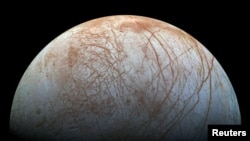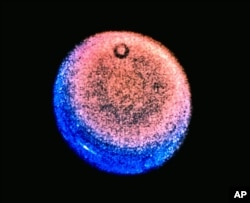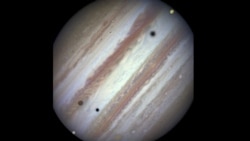Astronomers have discovered 12 additional moons orbiting Jupiter. That means Jupiter now has a total of 92 moons, more than any other planet in our solar system.
The new moons were recently added to a list kept by the internationally recognized Minor Planet Center. The center –operated by the International Astronomical Union – continually records the positions of planets, moons and other space objects.
Scott Sheppard is an astronomer with the Carnegie Institution of Science. He was a member of the team that made the latest discoveries.
Sheppard told The Associated Press (AP) that the new moons were found using telescopes in Hawaii and Chile in 2021 and 2022. The first sightings were confirmed with additional observations.
The latest moons are between one and three kilometers in size, he said. "I hope we can image one of these outer moons close-up in the near future to better determine their origins," Sheppard added.
Sheppard has already taken part in 70 moon discoveries for Jupiter. He also discovered moons orbiting Saturn.
Sheppard noted that Jupiter’s newly discovered moons have not yet been named. He said only half of them are big enough – at least 1.5 kilometers – to justify a name.
In our solar system, some planets have numerous moons while some have none.
The American Space Agency NASA reports that Saturn had been the planet with the most moons until the most recent announcement. Saturn currently is known to have 83 moons. Saturn held the top position since 2019 when Sheppard’s team discovered 20 additional moons. Before that, Jupiter was the solar system’s leader with 79 confirmed moons.
Sheppard told the AP he expects to keep adding moons to both Jupiter and Saturn in the future.
Scientists believe Jupiter and Saturn’s many small moons formed from crashes with larger moons, asteroids, or other space objects. Uranus and Neptune also have many small moons. But since those planets are much farther from Earth, discovering new moons orbiting those planets is more difficult, Sheppard said.
Saturn has two so-called “ocean moons,” called Enceladus and Titan. The pieces of ice and rock that form rings around Saturn are not considered moons themselves, NASA said. But moons do exist within the planet’s rings and help to keep the rings in line.
Jupiter’s moons include the largest in the solar system, Ganymede, an ocean moon called Europa and a volcanic moon named Io. NASA notes that many of Jupiter’s outer moons have what are called retrograde orbits. That means they orbit in the opposite direction that the planet spins in.
Of the other major planets in our solar system, Uranus has 27 confirmed moons, while Neptune has 14. Mars has two and Earth has one. Venus and Mercury have no confirmed moons.
Earth’s moon is thought to have formed when a large space body about the size of Mars crashed into Earth. Scientists believe material from the resulting crash came together to form our moon about 4.5 billion years ago.
The huge gas planet Jupiter remains one of the most interesting for astronomers. Jupiter’s atmosphere is made up mostly of hydrogen and helium. It orbits about 778 million kilometers from our sun.
This year, the European Space Agency (ESA) plans to launch a spacecraft to explore Jupiter. The Jupiter Icy Moons Explorer spacecraft, called JUICE, is expected to launch sometime in April. The mission will make detailed observations of Jupiter and its three large moons.
ESA says it hopes the observations will help scientists learn more about Jupiter’s complex environment as they use the planet as a model for other gas giants across the universe.
I’m Bryan Lynn.
Bryan Lynn wrote this story for VOA Learning English, based on reports from The Associated Press, The Planetary Society and NASA.
___________________________________________________________
Words in This Story
determine – n. to discover facts or truth about something
origins – n. where something begins or comes from
justify – v. to give a good enough reason to make something seem acceptable
______________________________________________________________
What do you think of this story? We want to hear from you. We have a new comment system. Here is how it works:
- Write your comment in the box.
- Under the box, you can see four images for social media accounts. They are for Disqus, Facebook, Twitter and Google.
- Click on one image and a box appears. Enter the login for your social media account. Or you may create one on the Disqus system. It is the blue circle with “D” on it. It is free.
Each time you return to comment on the Learning English site, you can use your account and see your comments and replies to them. Our comment policy is here.













Forum